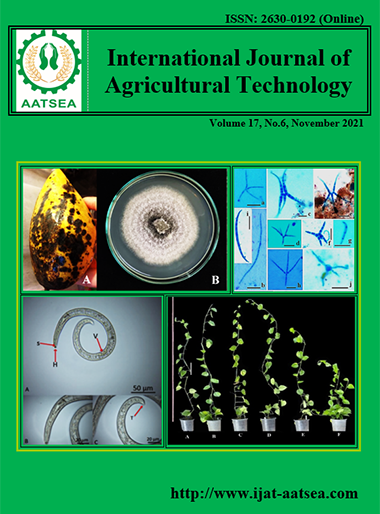Biological activities of extracts and beauvericin from Cordyceps cateniannulata CPA14V
Main Article Content
Abstract
Antioxidant activities in vitro were recorded for antimicrobial and cytotoxic activities (liver cancer cells (HepG2), prostate cancer cells (PC-3) and normal cells (Vero)) of the extract of ethanol (CCM), n-hexane (CCH), dichloromethane (CCD), ethyl acetate (CCE), and water (CCW), and a cyclooligomer depsipeptide, beauvericin (CC1) from Cordyceps cateniannulata CPA14V. The results showed that CCD contained the main compound, beauvericin (CC1) and exhibited higher activities than the other extracts. Especially, CCD and CC1 displayed good cytotoxicity against HepG2 and PC-3 cell lines with IC50 values from 19.17 to 45.29 µg/mL; the CCM and CCD exhibited good free radical scavenging capacity and antioxidant activity with SC50 values of 102.95 and 86.87 μg/mL, respectively; CC1 demonstrated potent antimicrobial activities with MIC value of 100 μg/mL (for Aspergillus niger, Escherichia coli, Fusarium oxysporum, Pseudomonas aeruginosa and Staphylococcus aureus) and MIC value of 200 μg/mL (for Bacillus subtillis, Candida albicans and Saccharomyces cerevisiae), CCM inhibited E. coli and C. albicans with MIC values of 200 μg/mL and A. niger with MIC values of 100 μg/mL. In addition, all samples did not show cytotoxicity to normal cells (Vero) at the tested concentrations
Article Details

This work is licensed under a Creative Commons Attribution-NonCommercial-NoDerivatives 4.0 International License.
References
Bogner, C. W., Kamdem, R. S., Sichtermann, G., Matthäus, C., Hölscher, D., Popp, J. and Schouten, A. (2017). Bioactive secondary metabolites with multiple activities from a fungal endophyte. Microbial biotechnology, 10:175-188.
Brand-Williams, W., Cuvelier, M.-E. and Berset, C. (1995). Use of a free radical method to evaluate antioxidant activity. LWT-Food science and Technology, 28:25-30.
Das, G., Shin, H.-S., Leyva-Gómez, G., Prado-Audelo, M. L. D., Cortes, H., Singh, Y. D. and Saklani, S. (2021). Cordyceps spp.: A review on its immune-stimulatory and other biological potentials. Frontiers in Pharmacology, 11: 2250.
Dzoyem, J. P., Melong, R., Tsamo, A. T., Maffo, T., Kapche, D. G., Ngadjui, B. T. and Eloff, J. N. (2017). Cytotoxicity, antioxidant and antibacterial activity of four compounds produced by an endophytic fungus Epicoccum nigrum associated with Entada abyssinica. Revista Brasileira de Farmacognosia, 27:251-253.
Hamill, R. L., Higgens, C., Boaz, H. and Gorman, M. (1969). The structure op beauvericin, a new depsipeptide antibiotic toxic to Artemia salina. Tetrahedron Letters 10: 4255-4258.
Ivanova, L., Skjerve, E., Eriksen, G. S. and Uhlig, S. (2006). Cytotoxicity of enniatins A, A1, B, B1, B2 and B3 from Fusarium avenaceum. Toxicon, 47:868-876.
Juan-García, A., Tolosa, J., Juan, C. and Ruiz, M.-J. (2019). Cytotoxicity, genotoxicity and disturbance of cell cycle in HepG2 cells exposed to OTA and BEA: single and combined actions. Toxins, 11:341.
Kuo, Y. C., Lin, L. C., Don, M. J., Liao, H. F., Tsai, Y. P., Lee, G. H. and Chou, C. J. (2002). Cyclodesipeptide and dioxomorpholine derivatives isolated from the insect-body portion of the fungus Cordyceps cicadae. J Chin Med, 13:209-219.
Mallebrera, B., Maietti, A., Tedeschi, P., Font, G., Ruiz, M. J. and Brandolini, V. (2017). Antioxidant capacity of trans-resveratrol dietary supplements alone or combined with the mycotoxin beauvericin. Food and chemical toxicology, 105:315-318.
Meerloo, J. V., Kaspers, G. and Cloos, J. (2011). Cancer Cell Culture. Methods in Molecular Biology (Methods and Protocols),(Eds.: I. Cree), Humana Press.
Mosmann, T. (1983). Rapid colorimetric assay for cellular growth and survival: application to proliferation and cytotoxicity assays. Journal of immunological methods 65:55-63.
Olatunji, O. J., Tang, J., Tola, A., Auberon, F., Oluwaniyi, O. and Ouyang, Z. (2018). The genus Cordyceps: An extensive review of its traditional uses, phytochemistry and pharmacology. Fitoterapia, 129:293-316.
Olleik, H., Nicoletti, C., Lafond, M., Courvoisier-Dezord, E., Xue, P., Hijazi, A.and Maresca, M. (2019). Comparative Structure–Activity Analysis of the Antimicrobial Activity, Cytotoxicity, and Mechanism of Action of the Fungal Cyclohexadepsipeptides Enniatins and Beauvericin. Toxins, 11:514.
Rachmawati, R., Kinoshita, H. and Nihira, T. (2017). Production of Insect Toxin Beauvericin from Entomopathogenic Fungi Cordyceps militaris by Heterologous Expression of Global Regulator. AGRIVITA, Journal of Agricultural Science, 40:177-184.
Sood, S., Sandhu, S. and Mukherjee, T. (2017). Pharmacological and Therapeutic Potential of Beauvericin: A Short Review. J Proteomics Bioinform, 10:18-23.
Sung, G.-H., Hywel Jones, N. L., Sung, J. M., Luangsa Ard, J. J., Shrestha, B. and Spatafora, J. W. (2007). Phylogenetic classification of Cordyceps and the clavicipitaceous fungi. Studies in mycology, 57:5-59.
Süssmuth, R., Müller, J., Von Döhren, H. and Molnár, I. (2011). Fungal cyclooligomer depsipeptides: from classical biochemistry to combinatorial biosynthesis. Natural product reports, 28:99-124.
Van, N. T. T., Viet, N. D. and Duong, M. L. (2021). Effects of Culture Conditions on Growth and Cyclooligomer Depsipeptides Biosynthesis of Cordyceps sp. CPA14V. VNU Journal of Science: Natural Sciences and Technology. https://doi.org/10.25073/2588-1140/vnunst.5273.
Vanden Berghe, D. A. (1991). Screening methods for antibacterial and antiviral agents from higher plants. Methods in plant biochemistry, 47-69.
Vlietinck, A. (1999). Screening methods for detection and evaluation of biological activities of plant preparations. Bioassay methods in natural product research and drug development, Springer, pp.37-52.
Wang, J., Zhang, D. M., Jia, J. F., Peng, Q. L., Tian, H. Y., Wang, L. and Ye, W. C. (2014). Cyclodepsipeptides from the ascocarps and insect-body portions of fungus Cordyceps. cicadae. Fitoterapia, 97:23-27.
Wang, Q. and Xu, L. (2012). Beauvericin, a bioactive compound produced by fungi: a short review. Molecules, 17:2367-2377.
Wang, X., Gong, X., Li, P., Lai, D. and Zhou, L. (2018). Structural diversity and biological activities of cyclic depsipeptides from fungi. Molecules, 23:169.
Yang, L., Tu, D., Zhao, Z. and Cui, J. (2017). Cytotoxicity and apoptosis induced by mixed mycotoxins (T-2 and HT-2 toxin) on primary hepatocytes of broilers in vitro. Toxicon, 129:1-10.
Zhang, H., Ruan, C., Bai, X., Zhang, M., Zhu, S. and Jiang, Y. (2016). Isolation and identification of the antimicrobial agent beauvericin from the endophytic Fusarium oxysporum 5-19 with NMR and ESI-MS/MS. BioMed research international 2016.


